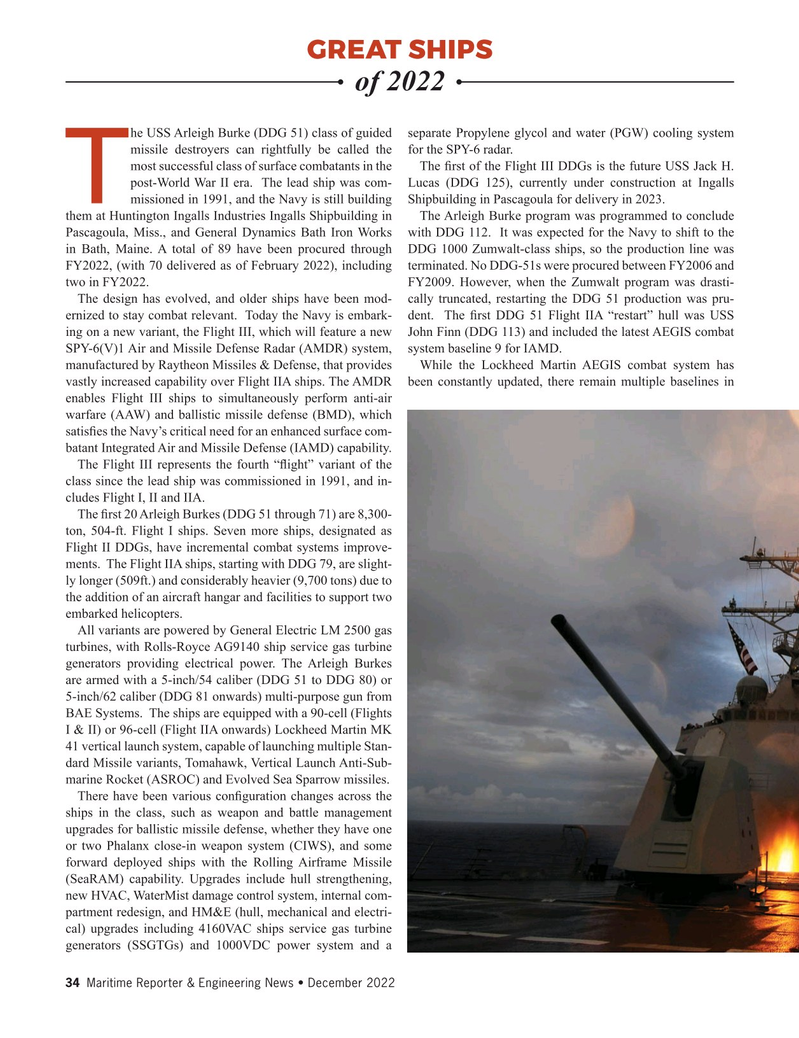
Page 34: of Maritime Reporter Magazine (December 2022)
Great Ships of 2022
Read this page in Pdf, Flash or Html5 edition of December 2022 Maritime Reporter Magazine
GREAT SHIPS of 2022 he USS Arleigh Burke (DDG 51) class of guided separate Propylene glycol and water (PGW) cooling system missile destroyers can rightfully be called the for the SPY-6 radar.
most successful class of surface combatants in the The ? rst of the Flight III DDGs is the future USS Jack H. post-World War II era. The lead ship was com- Lucas (DDG 125), currently under construction at Ingalls
Tmissioned in 1991, and the Navy is still building Shipbuilding in Pascagoula for delivery in 2023.
them at Huntington Ingalls Industries Ingalls Shipbuilding in The Arleigh Burke program was programmed to conclude
Pascagoula, Miss., and General Dynamics Bath Iron Works with DDG 112. It was expected for the Navy to shift to the in Bath, Maine. A total of 89 have been procured through DDG 1000 Zumwalt-class ships, so the production line was
FY2022, (with 70 delivered as of February 2022), including terminated. No DDG-51s were procured between FY2006 and two in FY2022. FY2009. However, when the Zumwalt program was drasti-
The design has evolved, and older ships have been mod- cally truncated, restarting the DDG 51 production was pru- ernized to stay combat relevant. Today the Navy is embark- dent. The ? rst DDG 51 Flight IIA “restart” hull was USS ing on a new variant, the Flight III, which will feature a new John Finn (DDG 113) and included the latest AEGIS combat
SPY-6(V)1 Air and Missile Defense Radar (AMDR) system, system baseline 9 for IAMD. manufactured by Raytheon Missiles & Defense, that provides While the Lockheed Martin AEGIS combat system has vastly increased capability over Flight IIA ships. The AMDR been constantly updated, there remain multiple baselines in enables Flight III ships to simultaneously perform anti-air warfare (AAW) and ballistic missile defense (BMD), which satis? es the Navy’s critical need for an enhanced surface com- batant Integrated Air and Missile Defense (IAMD) capability.
The Flight III represents the fourth “? ight” variant of the class since the lead ship was commissioned in 1991, and in- cludes Flight I, II and IIA.
The ? rst 20 Arleigh Burkes (DDG 51 through 71) are 8,300- ton, 504-ft. Flight I ships. Seven more ships, designated as
Flight II DDGs, have incremental combat systems improve- ments. The Flight IIA ships, starting with DDG 79, are slight- ly longer (509ft.) and considerably heavier (9,700 tons) due to the addition of an aircraft hangar and facilities to support two embarked helicopters.
All variants are powered by General Electric LM 2500 gas turbines, with Rolls-Royce AG9140 ship service gas turbine generators providing electrical power. The Arleigh Burkes are armed with a 5-inch/54 caliber (DDG 51 to DDG 80) or 5-inch/62 caliber (DDG 81 onwards) multi-purpose gun from
BAE Systems. The ships are equipped with a 90-cell (Flights
I & II) or 96-cell (Flight IIA onwards) Lockheed Martin MK 41 vertical launch system, capable of launching multiple Stan- dard Missile variants, Tomahawk, Vertical Launch Anti-Sub- marine Rocket (ASROC) and Evolved Sea Sparrow missiles.
There have been various con? guration changes across the ships in the class, such as weapon and battle management upgrades for ballistic missile defense, whether they have one or two Phalanx close-in weapon system (CIWS), and some forward deployed ships with the Rolling Airframe Missile (SeaRAM) capability. Upgrades include hull strengthening, new HVAC, WaterMist damage control system, internal com- partment redesign, and HM&E (hull, mechanical and electri- cal) upgrades including 4160VAC ships service gas turbine generators (SSGTGs) and 1000VDC power system and a 34 Maritime Reporter & Engineering News • December 2022
MR #12 (34-43).indd 34 12/5/2022 3:18:03 PM

 33
33

 35
35
